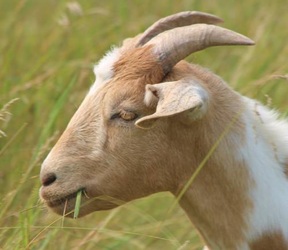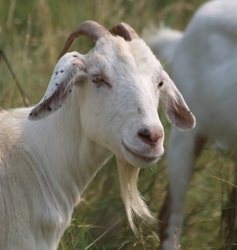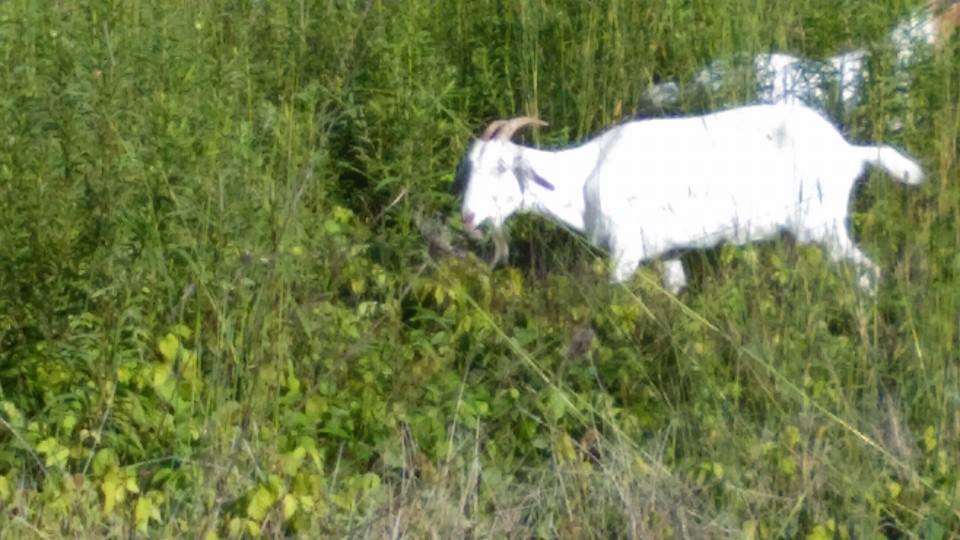|
Mares eat oats and does eat oats and little lambs eat ivy, a kid’ll eat ivy, too, wouldn’t you? We have our share of poison ivy on the property and Marty is likely to stumble through the leaves of three. For at least the past year, we have been thinking about eradicating the ivy patch and these two have been hired to do the work. The lyric from the 1940's whimsical tune Mairzy Doats quoted above indicates a kid'll eat ivy too. So for the past two weeks the two grown up kids, named Ivy and Kid (Kid has the brown or red face), have been on our property. Yesterday Ivy was observed happily chewing the nasty leaves of three, so as our neighbor says "You go girl."
78 Comments
The battle started quietly. Late May, I was preparing to leave on a business trip. I would be gone all week. There was no need to purchase my usual lunch supplies. I mentioned to Julie that the lettuce in the garden looked great and that we would have salad greens the week I returned. Our normal brown bag lunches included salads.
On return from the trip, I wandered through the garden. Finally, germination was happening. The plants like tomatoes and peppers planted from starts were perking up and looking good. The lettuce was gone. Mowed down to the ground! Then we saw the mowers and evidence of their presence. Rabbits, woodchucks and deer. The first battle engagements were lost to the woodchucks. My lack of shooting skills are to blame. I actually shot one woodchuck that limped off the battle field. One of the cute little suckers stared at me from the tunnel dug under the barn wall. The second battle involved sophisticated weaponry in the form of 330 Conibear traps. Four of them strategically located in the paths dug under the barn walls. Gardener 7 Woodchucks ? Elderberries are blooming along the roadsides; a sure sign that summer has begun.
Sambucus canadensis is our native elder, a large shrub with a broad profile, often found at the edge of ditches, low areas and fence rows. Plants are in their peak bloom now, covered with broad, flat flower clusters six to ten inches across, each composed of hundreds of tiny flowers. We do not often choose to grow elderberries as landscape plants. Their overall appearance is irregular and requires pruning to look good in a manicured garden. Best in full sun and a moist, well-drained soil, tolerant of spring wet and a range of soil types, but also spreads by forming colonies as new plants sprout from the roots. They are excellent for larger spaces and forming a transition from the landscape to natural areas. Flowers are followed by blue to deep purple berries, which attract many birds that provide an entertaining dance as they hover and dart to pluck the berries while on the wing. The tiny fruits should not be eaten fresh by people, however, as they cause stomach upset and diarrhea. However, they are quite edible and very delicious when cooked in desserts, pies or preserves or fermented into wine. Flowers are edible, too, and can be battered and fried, added to pancakes to lighten their texture, or steeped to make a fragrant tea. Historically all parts of the plant have been valued for crafting tools, dyes and for a wide range of medicinal uses, but avoid dabbling with the medicinal. American elderberry plants can be purchased through nurseries that offer native fruits, and they are a good addition to the home orchard or berry patch. Best fruiting occurs when two or more different varieties are grown close enough for cross pollination. Adams is one of the best for high yields, often sold with Johns, though native stands or another named variety can also serve as the pollinator. European or black elder, Sambucus nigra, is very similar to the American species, from flower to fruit to landscape appearance—in fact, some botanists feel that our canadensis is a subspecies of nigra. Flowers are fragrant, and foliage has a pungent odor, unpleasant to some. This species brings a number of more ornamental varieties to the garden, however. Several selections offer deep burgundy foliage and are readily available. Black Beauty adds coordinating pink-tinted flowers, as does its cut-leaf counterpart, Black Lace. Laciniata has green foliage so finely cut that it resembles a lace-leaf Japanese maple. Leaves of Marginata are edged in a creamy yellow that matures to white as the season progresses. Aurea has golden foliage, and Madonna’s is green with golden edges and marbling. Pulverenta is white swirled with green. The European species has a more rangy habit, and looks best when cut back hard in spring to promote lots of fresh new growth. My experience has been that the plants often die back to the ground over winter, much like butterfly bushes will in our area, so it’s an easy maintenance to remember. With this trimming, plants are more easily worked into mixed landscape plantings where their foliage can be paired with flowers and other foliage for beautiful effects. Some varieties of both species have pretty red berries instead of the usual deep blue-purple, but before eating these, do be sure that you are sure of the variety. There are some other species of Elder whose berries are always red and are not edible. As you drive the country roads over the next few weeks, enjoy the seasonal display. |
AuthorsJulie has worked in the horticulture world for over 25 years. She has a degree in English Literature from University of Michigan. She is a member of the American Garden Writers Association. Archives
November 2017
Friends in the business
We recommend the plants and services offered by Nash Nurseries. Categories
All
|




 RSS Feed
RSS Feed